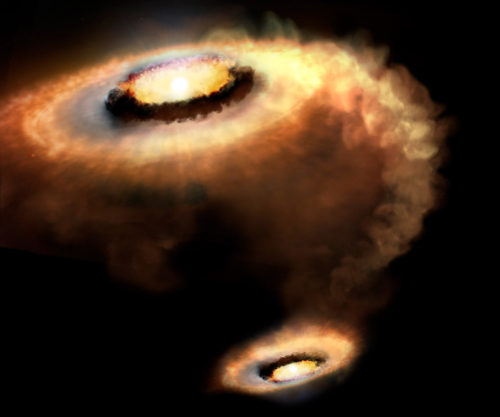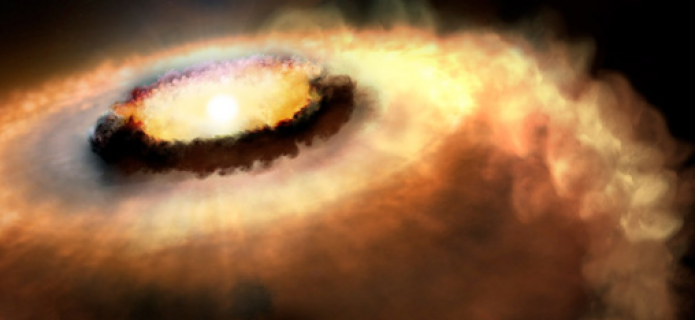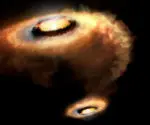ALMA Studies Infant Sun-like Solar System to Try and Catch the Wind
22 September, 2014 / Read time: 5 minutes
Astronomers using the Atacama Large Millimeter/submillimeter Array (ALMA) have observed what may be the first-ever signs of windy weather around a T Tauri star, an infant analog of our own Sun. This may help explain why some T Tauri stars have disks that glow weirdly in infrared light while others shine in a more expected fashion.

Artist’s rendition of AS 205 N, a T Tauri star that is part of a multiple star system. | Credit: AP. Marenfeld & NOAO/AURA/NSF
T Tauri stars are the infant versions of stars like our Sun. They are relatively normal, medium-size stars that are surrounded by the raw materials to build both rocky and gaseous planets. Though nearly invisible in optical light, these disks shine in both infrared and millimeter-wavelength light.
"The material in the disk of a T Tauri star usually, but not always, emits infrared radiation with a predictable energy distribution,"said Colette Salyk, an astronomer with the National Optical Astronomical Observatory (NOAO) in Tucson, Ariz., and lead author on a paper published in the Astrophysical Journal. "Some T Tauri stars, however, like to act up by emitting infrared radiation in unexpected ways."
To account for the different infrared signature around such similar stars, astronomers propose that winds may be emanating from within some T Tauri stars’ protoplanetary disks. These winds could have important implications for planet formation, potentially robbing the disk of some of the gas required for the formation of giant Jupiter-like planets, or stirring up the disk and causing the building blocks of planets to change location entirely. These winds have been predicted by astronomers, but have never been clearly detected.
Using ALMA, Salyk and her colleagues looked for evidence of a possible wind in AS 205 N – a T Tauri star located 407 light-years away at the edge of a star-forming region in the constellation Ophiuchus, the Snake Bearer. This star seems to exhibit the strange infrared signature that has intrigued astronomers.
With ALMA’s exceptional resolution and sensitivity, the researchers were able to study the distribution of carbon monoxide around the star. Carbon monoxide is an excellent tracer for the molecular gas that makes up stars and their planet-forming disks. These studies confirmed that there was indeed gas leaving the disk’s surface, as would be expected if a wind were present. The properties of the wind, however, did not exactly match expectations.
This difference between observations and expectations could be due to the fact that AS 205 N is actually part of a multiple star system – with a companion, dubbed AS 205 S, that is itself a binary star.
This multiple star arrangement may suggest that the gas is leaving the disk’s surface because it’s being pulled away by the binary companion star rather than ejected by a wind.
"We are hoping these new ALMA observations help us better understand winds, but they have also left us with a new mystery,"said Salyk. "Are we seeing winds, or interactions with the companion star?"
The study’s authors are not pessimistic, however. They plan to continue their research with more ALMA observations, targeting other unusual T Tauri stars, with and without companions, to see whether they show these same features.
T Tauri stars are named after their prototype star, discovered in 1852 – the third star in the constellation Taurus whose brightness was found to vary erratically. At one point, some 4.5 billion years ago, our Sun was a T Tauri star.
Other authors include Klaus Pontoppidan, Space Telescope Science Institute; Stuartt Corder, Joint ALMA Observatory; Diego Muñoz, Center for Space Research, Department of Astronomy, Cornell University; and Ke Zhang and Geoffrey Blake, Division of Geological & Planetary Sciences, California Institute of Technology.
More Information
Other authors include Klaus Pontoppidan, Space Telescope Science Institute; Stuartt Corder, Joint ALMA Observatory; Diego Muñoz, Center for Space Research, Department of Astronomy, Cornell University; and Ke Zhang and Geoffrey Blake, Division of Geological & Planetary Sciences, California Institute of Technology,
The Atacama Large Millimeter/submillimeter Array (ALMA), an international astronomy facility, is a partnership of the European Organisation for Astronomical Research in the Southern Hemisphere (ESO), the U.S. National Science Foundation (NSF) and the National Institutes of Natural Sciences (NINS) of Japan in cooperation with the Republic of Chile. ALMA is funded by ESO on behalf of its Member States, by NSF in cooperation with the National Research Council of Canada (NRC) and the Ministry of Science and Technology (MOST) in Taiwan and by NINS in cooperation with the Academia Sinica (AS) in Taiwan and the Korea Astronomy and Space Science Institute (KASI).
ALMA construction and operations are led by ESO on behalf of its Member States; by the National Radio Astronomy Observatory (NRAO), managed by Associated Universities, Inc. (AUI), on behalf of North America; and by the National Astronomical Observatory of Japan (NAOJ) on behalf of East Asia. The Joint ALMA Observatory (JAO) provides the unified leadership and management of the construction, commissioning and operation of ALMA.
Links
Link to Research Paper on The Astrophysical Journal
Contacts
Dr. Colette Salyk
National Optical Astronomy Observatory
950 N Cherry Ave, Tucson AZ 85719 USA
E-mail: [email protected]
Valeria Foncea
Education and Public Outreach Officer
Joint ALMA Observatory
Santiago, Chile
Tel: +56 2 467 6258
Cell: +56 9 75871963
Email: [email protected]
Charles E. Blue
Public Information Officer
National Radio Astronomy Observatory
Charlottesville, Virginia, USA
Tel: +1 434 296 0314
Cell: +1 434.242.9559
Email: [email protected]
Richard Hook
Public Information Officer, ESO
Garching bei München, Germany
Tel: +49 89 3200 6655
Cell: +49 151 1537 3591
Email: [email protected]
Masaaki Hiramatsu
Education and Public Outreach Officer, NAOJ Chile
Observatory Tokyo, Japan
Tel: +81 422 34 3630
Email: [email protected]

